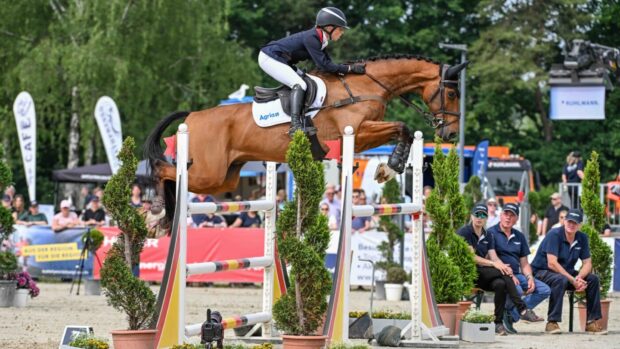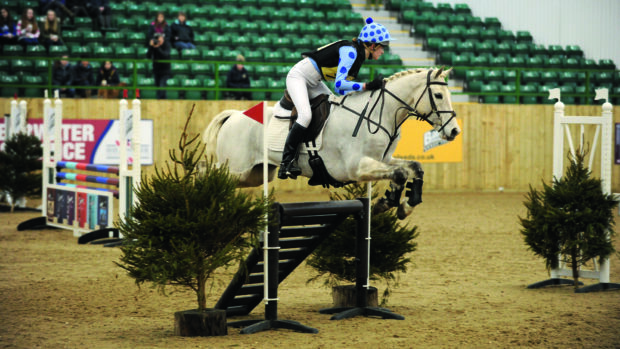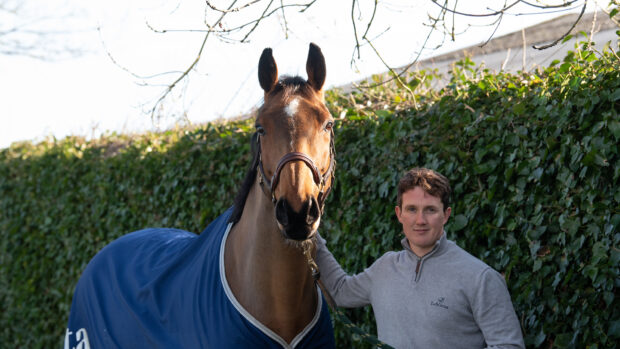At a recent masterclass, sponsored by Dodson & Horrell (21 January), top event riders Tom McEwen (T) and Richard Jones (R, pictured top) shared some very useful advice on how to warm your horse or pony up for showjumping and how to improve technique and performance in this phase of eventing.
Richard was riding a 10-year-old gelding, who was fourth in the eight- and nine-year-old CIC3* class at Blenheim last year, while Tom was riding a seven-year-old mare, who has competed to British Eventing (BE) novice level.
Here’s some top tips from the pair on how to best warm your horse or pony up, ready to tackle a course of showjumps and how you can train better to help improve results…
1. R — Before you start jumping, make sure the quality of your canter and rhythm are established, then once you start jumping, you also need to focus on straightness.
2. T — Even if your horse is green to the warm-up fence — I usually start with a cross pole and then work up from a small upright, to an oxer, getting bigger, before jumping a final upright — give them time to find their balance, and trot to a few fences first if you need to.

Tom jumping a cross-pole
3. R — When you start jumping, focus on a point straight ahead of you and ride to it — this will help you achieve the desired straightness between horse and rider.
4. T — Make sure all downwards and upwards transitions are good — just because you’re now jumping, doesn’t mean that you can throw these out of the window.
5. R — If your horse knocks a fence down, it’s not the end of the world, so long as they learn from it. Allow them to come round to the fence again, and don’t change your riding — this will give you the opportunity to see if your horse has learnt from his mistake.
6. T — I use outside bend on the corner approaching the fence to help maintain the horse’s straightness.

Tom working on his canter
7. R — Your showjumping warm-up needs to be methodical and straightforward to instill confidence in your horse before going into the competition arena.
8. T — I always try to use snaffle bridles on my horses — I don’t rely on changing to stronger bits to compensate for a lack of training.
9. T — I don’t let the horse fall back to trot and walk after jumping a fence — I try to keep working them for a little bit longer so that they don’t get into the habit of giving up after a jump or course of fences.
10. R — If you have a walk break, make sure both you and your horse are focused and back on the bridle before jumping another fence — don’t just pick up canter and jump straight away.
11. T — I train with my body and balance with my eyes — your eyes always need to be one step ahead of what you’re doing — this helps with the horse’s development at all levels.
12. R — Some people use training strides and show strides — I don’t do this at all — I always like my horses to be on the bridle and replicating what they will need to do in the competition arena.
13. T — I use pots of flowers at the end of the arena to encourage me to ride around corners properly.
14. R — Routine and repetition is key — the exercises my experienced horses are doing are exactly the same as my young horses — I don’t use polework or gridwork — I keep it simple, which all helps with routine, repetition, confidence and trust, and will hopefully result in a top horse.

15. T — I have no problem in using circles in-between fences while schooling at home, or even moving away from jumping completely for a few minutes if my horse starts to lose a little of its rideability. I would much rather go with my horses in this way rather than going to my hand and pulling to get them back with me.
Article continues below…
You might also be interested in:

Jumping a horse away from home for the first time: 13 top tips from Michael and Jack Whitaker
Here’s some top tips from the pair on how to introduce a horse to a new environment and build confidence…
16. T — Only ride to what your horse is currently capable of in its body — pushing too far beyond this will be counterproductive.
17. R — You have to take each horse on a case-by-case basis when riding them — don’t think “oh, they’re five now, so they need to be doing this” — as long as your horse or pony learns something each time you ride them, you will reach your goals.
18. R — I use snaffle bridles and no martingales. I think that using a martingale covers up a gap in training. I always prefer to think about why a horse is putting its head in the air — it’s often because they are weak. So I’d rather go back and work on this as opposed to thinking “oh, I’ll just put a martingale on”.
19. — R — If you suffer from nerves, think about this saying someone once told me: “You have to have confidence in the training you have done with your horse”. If you know that you and your horse have done all the preparation required in order to compete at the level you have chosen, then you shouldn’t suffer with nerves.
For all the latest news analysis, competition reports, interviews, features and much more, don’t miss Horse & Hound magazine, on sale every Thursday.




